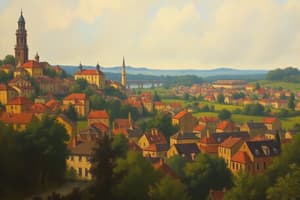Podcast
Questions and Answers
What type of city is Jamshedpur?
What type of city is Jamshedpur?
- Educational and Cultural City
- Industrial City (correct)
- Port City
- Commercial City
What is the main characteristic of conurbations?
What is the main characteristic of conurbations?
- Being a single large city
- Being a coastal city with a port
- Formed by the merging of multiple towns or cities (correct)
- Being a group of cities with a common economy
What is the primary cause of urban sprawl?
What is the primary cause of urban sprawl?
- Inadequate public transportation
- Lack of green spaces
- High-rise buildings
- Increased car ownership (correct)
What is the primary objective of town planning?
What is the primary objective of town planning?
What is a major problem associated with slums?
What is a major problem associated with slums?
What is the primary characteristic of a nucleated or clustered settlement?
What is the primary characteristic of a nucleated or clustered settlement?
Which type of rural settlement pattern is often seen in planned settlements?
Which type of rural settlement pattern is often seen in planned settlements?
What is a characteristic of the morphology of rural settlements?
What is a characteristic of the morphology of rural settlements?
What type of city is characterized by areas with planned grid patterns, wide streets, and distinct European architectural styles?
What type of city is characterized by areas with planned grid patterns, wide streets, and distinct European architectural styles?
What is the primary characteristic of urban villages in India?
What is the primary characteristic of urban villages in India?
Study Notes
Rural Settlements
- Types of Rural Settlements:
- Isolated or Dispersed Settlements: scattered houses over a large area
- Linear Settlements: buildings along a road, river, or valley
- Nucleated or Clustered Settlements: compact, closely knit pattern
- Circular or Round Settlements: houses around a central feature
- Patterns of Rural Settlements:
- Grid Pattern: grid-like structure, often in planned settlements
- Radial Pattern: buildings radiate out from a central point
- Checkerboard Pattern: alternating patterns of land use
- Linear Pattern: buildings follow a linear path
- Morphology of Rural Settlements:
- Physical Layout: influenced by natural features, available land, and agricultural practices
- Housing Styles: reflect local materials and climatic conditions
- Infrastructure: roads, water supply, schools, and marketplaces
Urban Developments
Morphology of Indian Cities:
- Historic Core: old fortifications, bazaars, and administrative buildings
- Colonial Influence: planned grid patterns, wide streets, and European architectural styles
- Post-Independence Development: planned residential and commercial areas with modern infrastructure
- Urban Villages: former rural areas with a mix of rural and urban features
Functional Classification of Indian Cities:
- Administrative Cities: capitals like New Delhi
- Industrial Cities: manufacturing centers like Jamshedpur
- Commercial Cities: major trading hubs like Mumbai
- Port Cities: coastal cities with major ports, like Chennai
- Educational and Cultural Cities: centers of learning and culture, such as Varanasi
Conurbations and Metropolitan Regions
Conurbations:
- Definition: large, extended urban areas formed by merging multiple towns or cities
- Examples in India: Mumbai Metropolitan Region, National Capital Region (NCR)
Metropolitan Regions:
- Characteristics: larger than conurbations, often encompassing multiple cities and towns with interdependent economies
- Governance: managed through metropolitan planning authorities to coordinate development
Urban Sprawl
Definition:
- Urban Sprawl: uncontrolled expansion of urban areas into rural or semi-rural areas
Causes:
- Population growth
- Increased car ownership
- Desire for larger living spaces
- Ineffective urban planning
Consequences:
- Loss of agricultural land
- Increased traffic congestion
- Environmental degradation
- Higher infrastructure costs
Slums and Associated Problems
Characteristics:
- Poor living conditions
- Inadequate access to clean water and sanitation
- Overcrowding
- Lack of secure tenure
Problems:
- Health issues due to unsanitary conditions
- Social issues, including crime and lack of education
- Economic challenges, including unemployment and underemployment
Town Planning
Objectives:
- Efficient land use
- Sustainable development
- Providing adequate infrastructure
- Ensuring a good quality of life for residents
Principles:
- Zoning regulations
- Urban design standards
- Public participation in planning
- Use of Geographic Information Systems (GIS) for planning
Problems of Urbanization and Remedies
Problems:
- Overcrowding
- ...
Studying That Suits You
Use AI to generate personalized quizzes and flashcards to suit your learning preferences.
Description
Explore the different types of rural settlements, including dispersed, linear, and nucleated settlements, and learn about their characteristic patterns and morphology.




